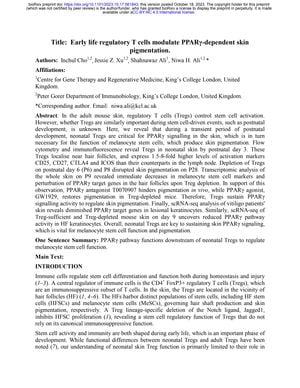Early Skin Seeding Regulatory T Cells Modulate PPARγ-Dependent Skin Pigmentation
October 2023
in “
bioRxiv (Cold Spring Harbor Laboratory)
”

TLDR Early regulatory T cells are crucial for normal skin pigmentation.
The study investigates the role of early skin seeding Regulatory T cells (ETregs) in neonatal skin, revealing their critical function in modulating Peroxisome proliferator-activated receptor-γ (PPARγ) signaling, which is essential for melanocyte stem cell (MeSC) mediated skin pigmentation. ETregs are detected as early as postnatal day 3 and are crucial for proper hair follicle melanocyte stem cell function, as their depletion between postnatal days 6-8 leads to defective skin pigmentation. Transcriptomic analysis shows that ETreg depletion disrupts PPARγ target gene expression in hair follicles, but this can be restored with PPARγ agonization. The study also links diminished PPARγ signaling in hair follicle epithelium to the depigmentation observed in vitiligo, highlighting the importance of ETregs in maintaining skin pigmentation during early development.






